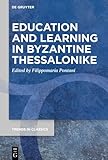Education and Learning in Byzantine Thessalonike / ed. by Filippomaria Pontani.
Material type: TextSeries: Trends in Classics - Supplementary Volumes ; 164Publisher: Berlin ; Boston : De Gruyter, [2024]Copyright date: 2024Description: 1 online resource (VI, 221 p.)Content type:
TextSeries: Trends in Classics - Supplementary Volumes ; 164Publisher: Berlin ; Boston : De Gruyter, [2024]Copyright date: 2024Description: 1 online resource (VI, 221 p.)Content type: - 9783111421476
- 9783111430232
- 9783111429410
- 370.9495/65 23/eng/20240528
- LA781.3 .E38 2024
- online - DeGruyter
- Issued also in print.
| Item type | Current library | Call number | URL | Status | Notes | Barcode | |
|---|---|---|---|---|---|---|---|
 eBook
eBook
|
Biblioteca "Angelicum" Pont. Univ. S.Tommaso d'Aquino Nuvola online | online - DeGruyter (Browse shelf(Opens below)) | Online access | Not for loan (Accesso limitato) | Accesso per gli utenti autorizzati / Access for authorized users | (dgr)9783111429410 |
Browsing Biblioteca "Angelicum" Pont. Univ. S.Tommaso d'Aquino shelves, Shelving location: Nuvola online Close shelf browser (Hides shelf browser)
Frontmatter -- Contents -- List of Figures -- Ἤσουνα, σβεῖς, ξαναγεννιέσαι: Paideia in Thessalonike Across the Centuries -- Michael Mitylenaios, Metropolitan of Thessalonike (11th c.), and His Unknown Hagiographical Work [BHG 789b] -- Eustathios’ Account of the Capture of Thessalonike by the Normans as Instruction in Political Education (paideia) -- Between Thessalonike and Constantinople: The Intellectual Life of Thessalonike in the Epistolography of the Palaeologan Era -- The Hagiology of Thessalonike in the Schedographic Production of John Pediasimos -- The Schedographers of Thessalonike in the Late Byzantine Period: The Example of Demetrios (?) Staphidakes -- Written Culture and Intellectual Circles during the Palaeologan Age: Once more on Demetrios Triklinios and His Friends -- “ὀνομάτων ἀττικῶν ἐκλογὴ οἷς οἱ δοκιμώτατοι χρῶνται τῶν παλαιῶν καί τινες αὐτῶν παρασημειώσεις καὶ διαφοραὶ πρὸς ἄλληλα κυροῦ Θωμᾶ τοῦ μαγίστρου”: Preliminary Remarks -- Glosses and Scholia signo lunae praeposito to Pindar’s Odes in the Ms. Athos Lavrae K A 52 -- Eruditi Thessalonicenses in the Entourage of Manuel II Palaiologos: Education and Learning in the Second City of the Empire — Research Data and Desiderata -- The Synopsis of the Kanonikon of John the Faster by Matthew Blastares: An Unconventional “Reading” from the Byzantine Periphery -- Collecting Books in Thessalonike: Manuel Tarchaneiotes Boullotes from Greece to Italy -- List of Contributors -- Index Librorum Manu Scriptorum -- General Index -- Index Locorum
restricted access online access with authorization star
http://purl.org/coar/access_right/c_16ec
Byzantine Thessaloniki has often been considered in its relationship with Constantinople, as a deuteragonist vis-à-vis the capital. However, from the 11th through the 15th century the symproteuousa has often played an important role in terms of the study, preservation and circulation of learning. The present volume collects 11 papers originating in a conference held at Thessaloniki's Kentro Istorias in May 2022. Some of them offer new elements and fresh discoveries on single erudites and their work, from Michael Mitylenaios to John Pediasimos, from Demetrios Triklinios to Thomas Magister, from Matthew Blastares to Manuel Boullotes. Hagiography, schedography, lexicography, philology on ancient Greek texts, and even canonical law, are among the genres practised by Thessalonian scholars over the centuries. Other papers offer thoughts on Eustathios' didactic aims, bird's-eye views of the city's intellectual milieux in the early Palaeologan era, or of the learned circles in Manuel II's entourage. The book acknowledges the "highs" and the "lows" in the cultural development of medieval Thessaloniki, and brings together essential elements towards an assessment of the city's role in the history of education and learning.
Issued also in print.
Mode of access: Internet via World Wide Web.
In English.
Description based on online resource; title from PDF title page (publisher's Web site, viewed 20. Nov 2024)









